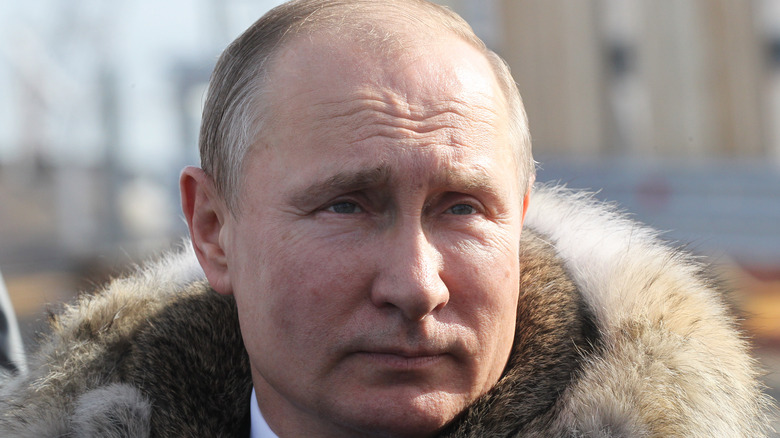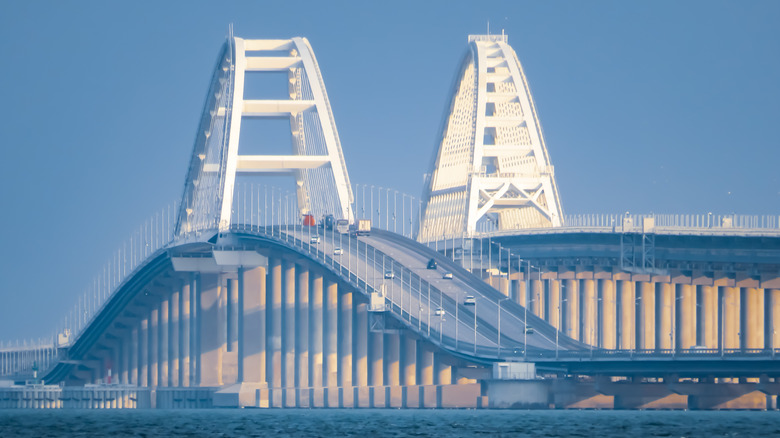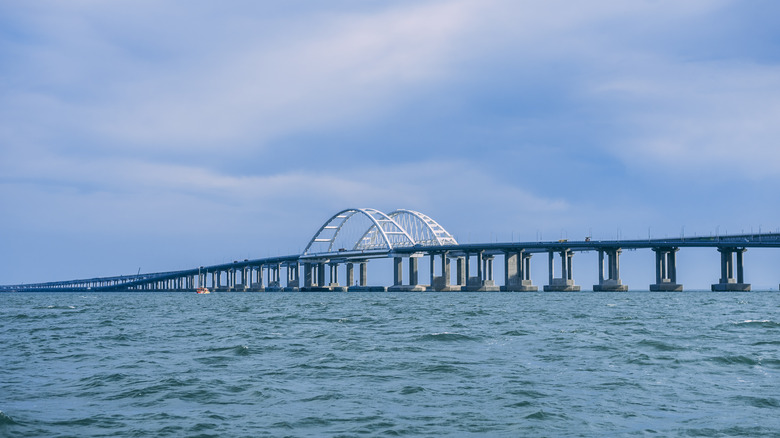The Controversial History Of Europe's Longest Bridge
In October 2022, amidst the hostilities between Ukraine and the Russian Federation, an explosion hit the Crimean Bridge that cost at least three lives and crippled a major transportation artery of the region, per The New York Times. The cause of the explosion is still not known; most believe it was caused by a bomb planted in a truck, but other reports have suggested it was an underwater drone strike (via NPR).
While the attack was obviously another bloody piece in the Russo-Ukranian War, less obvious was the fact that the bombing also had some significant symbolism behind it. The Crimean Bridge, the longest bridge in Europe, has an incredibly controversial history despite its short four years of existence.
To give some brief background, Russia launched its first invasion into Ukraine in 2014 by sending troops to the Crimean peninsula, declaring it an autonomous region, and then annexing the land as its own. The United States and other European allies did not take material action to help Ukraine and instead allowed the Russian Federation to gain a foothold in the region, per CNBC.
The Crimean Bridge was one of the biggest examples of Russia's foothold into Ukraine. Here's a rundown of the bridge's importance to Russia and how it has affected the 2022 war.
The Crimean Bridge linked Russia to Ukraine
The most obvious purpose of the bridge was to link the Crimean peninsula with Russia. Before, the only access between the two regions was either by ferry across the Kerch Strait or to travel within Ukraine along its coast on the Sea of Azov. The 12-mile bridge enabled Russia to open new trade routes, enact travel, and provide supplies to rebels to the region. Because the bridge was seen as a clear move to strengthen Russia's claim on Crimea and advance Russian militarization in the region, the UN General Assembly condemned its construction, as did Ukraine, the European Union, and the U.S. (via The Moscow Times). However, construction commenced despite international outcry in 2016, and even finished ahead of schedule, per DW.
The bridge's early completion was surprising since many of the companies behind building the bridge were technically dealing with sanctions from much of the West. The fact that the construction was so successful was a message to Europe and the United States that Russia was ready to fight and overcome those economic penalties.
Moreover, the bridge didn't just create a new land route from Russia to Crimea. It also helped further Russia's naval operations in the Black Sea and Azov Sea. With the ability to grow its naval bases on Crimea, Russia began flexing its maritime muscle and even intercepted three Ukrainian naval ships in November 2018 (via The Calhoun Post-Graduate Naval School).
Putin's end-game
The importance of the bridge extends beyond just Ukraine and Crimea. President Putin is known to be obsessed with his legacy as a great leader of Russia and has overtly stated that his eventual goal is to recreate the 21st century version of the Russian Empire that was once forged by Peter the Great.
"Peter the Great waged the great northern war for 21 years," he said in a June 2022 speech (via The Guardian). "Apparently, it is also our lot to return [what land is Russia's] and strengthen [the country]. And if we proceed from the fact that these basic values form the basis of our existence, we will certainly succeed in solving the tasks that we face."
Thus, Putin has two dueling desires: sheer conquest, and ways to "strengthen" Russia. Construction projects have been one of Putin's favored ways of achieving the latter — just like Peter the Great was known for the early construction of St. Petersburg. Previously, Putin had bragged about building both the Sochi Winter Games complex and the 2018 FIFA World Cup Stadium, according to The Moscow Times.
In other words, the Crimean Bridge was supposed to showcase Russia's engineering prowess and ascent into a modern superpower, and function as a keystone in Putin's dream of creating new empire, as noted by The New York Times.


